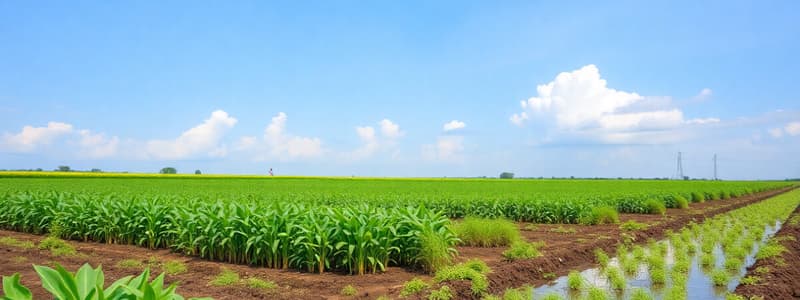Podcast
Questions and Answers
What may be a challenge when shifting to sustainable practices?
What may be a challenge when shifting to sustainable practices?
- Lack of government regulations
- Lower consumer demand for green products
- Initial investments and higher costs (correct)
- Immediate technological solutions available
What is crucial for addressing technological gaps in sustainable development?
What is crucial for addressing technological gaps in sustainable development?
- Ongoing research and development (correct)
- Increased consumer spending
- Immediate implementation of existing technologies
- Standardization of global practices
Why is global cooperation important for sustainable development?
Why is global cooperation important for sustainable development?
- Issues often transcend national boundaries (correct)
- It simplifies local policy making
- Environmental issues are localized
- Collaboration reduces technology costs
What does resource sustainability primarily aim to achieve?
What does resource sustainability primarily aim to achieve?
What does transitioning to a sustainable economy primarily require?
What does transitioning to a sustainable economy primarily require?
Which of the following best describes renewable resources?
Which of the following best describes renewable resources?
What is the relationship between economic activity and environmental sustainability?
What is the relationship between economic activity and environmental sustainability?
Which human activity is considered a significant threat to resource sustainability?
Which human activity is considered a significant threat to resource sustainability?
What characterizes non-renewable resources?
What characterizes non-renewable resources?
Which factor is NOT a human-induced factor affecting resource sustainability?
Which factor is NOT a human-induced factor affecting resource sustainability?
How can societies promote resource sustainability?
How can societies promote resource sustainability?
What is a key principle behind resource sustainability?
What is a key principle behind resource sustainability?
Which of the following is an example of a renewable resource?
Which of the following is an example of a renewable resource?
What is one key benefit of investing in renewable energy sources?
What is one key benefit of investing in renewable energy sources?
How do recycling and reuse programs contribute to sustainability?
How do recycling and reuse programs contribute to sustainability?
Which of the following describes a challenge in achieving sustainability?
Which of the following describes a challenge in achieving sustainability?
What role do government policies play in promoting sustainable practices?
What role do government policies play in promoting sustainable practices?
What is a primary goal of sustainable economic development?
What is a primary goal of sustainable economic development?
Which approach emphasizes responsible consumption for sustainability?
Which approach emphasizes responsible consumption for sustainability?
What can consumers do to support sustainability?
What can consumers do to support sustainability?
What is one potential consequence of environmental degradation?
What is one potential consequence of environmental degradation?
What is a potential negative consequence of increasing population growth?
What is a potential negative consequence of increasing population growth?
How can technological advancements affect resource utilization?
How can technological advancements affect resource utilization?
What is a critical factor for measuring the environmental impact of economic activities?
What is a critical factor for measuring the environmental impact of economic activities?
What does the carbon footprint indicate?
What does the carbon footprint indicate?
Which indicator is used to assess the amount of land required for resources?
Which indicator is used to assess the amount of land required for resources?
What is one effect of climate change on resources?
What is one effect of climate change on resources?
What element is crucial in guiding policy decisions for sustainable practices?
What element is crucial in guiding policy decisions for sustainable practices?
What is a consequence of resource extraction for economic development if not managed sustainably?
What is a consequence of resource extraction for economic development if not managed sustainably?
Flashcards
Resource Sustainability
Resource Sustainability
The ability to use natural resources without depleting them for future generations.
Renewable Resources
Renewable Resources
Resources that can replenish naturally over time, like solar and wind energy.
Non-Renewable Resources
Non-Renewable Resources
Resources that cannot be replenished quickly, like fossil fuels and minerals.
Human-induced Factors
Human-induced Factors
Signup and view all the flashcards
Natural Factors
Natural Factors
Signup and view all the flashcards
Economic Prosperity
Economic Prosperity
Signup and view all the flashcards
Environmental Sustainability
Environmental Sustainability
Signup and view all the flashcards
Population Growth Impact
Population Growth Impact
Signup and view all the flashcards
Tech Advancements & Sustainability
Tech Advancements & Sustainability
Signup and view all the flashcards
Economic Growth & Environment
Economic Growth & Environment
Signup and view all the flashcards
Climate Change & Resources
Climate Change & Resources
Signup and view all the flashcards
Carbon Footprint
Carbon Footprint
Signup and view all the flashcards
Water Footprint
Water Footprint
Signup and view all the flashcards
Land Footprint
Land Footprint
Signup and view all the flashcards
Measuring Environmental Impact
Measuring Environmental Impact
Signup and view all the flashcards
Sustainable Resource Utilization
Sustainable Resource Utilization
Signup and view all the flashcards
Renewable Energy
Renewable Energy
Signup and view all the flashcards
Resource Recycling & Reuse
Resource Recycling & Reuse
Signup and view all the flashcards
Conservation & Efficiency
Conservation & Efficiency
Signup and view all the flashcards
Circular Economy
Circular Economy
Signup and view all the flashcards
Sustainable Economic Development
Sustainable Economic Development
Signup and view all the flashcards
Sustainable Policies
Sustainable Policies
Signup and view all the flashcards
Business Innovation
Business Innovation
Signup and view all the flashcards
Consumer Choices
Consumer Choices
Signup and view all the flashcards
Economic Growth vs. Environmental Protection
Economic Growth vs. Environmental Protection
Signup and view all the flashcards
Challenges of Sustainability
Challenges of Sustainability
Signup and view all the flashcards
Sustainable Development
Sustainable Development
Signup and view all the flashcards
Economic Costs (Sustainability)
Economic Costs (Sustainability)
Signup and view all the flashcards
Technological Limits
Technological Limits
Signup and view all the flashcards
Global Cooperation
Global Cooperation
Signup and view all the flashcards
Time Scale (Sustainability)
Time Scale (Sustainability)
Signup and view all the flashcards
Sustainable Economic Development
Sustainable Economic Development
Signup and view all the flashcards
Study Notes
Introduction: The Delicate Balance of Economic Activity and Environmental Sustainability
- Our planet faces a challenge balancing economic success with environmental protection.
- Growing human societies demand more resources, stressing ecosystems.
- Balancing economic activity and environmental sustainability is crucial for a healthy future.
The Concept of Resource Sustainability
- Resource sustainability is using resources without harming future generations.
- It involves using resources efficiently and responsibly.
- It's about meeting current needs without compromising future generations' ability to do the same.
- Resources are utilized in ways that minimize depletion and pollution, while promoting regeneration and conservation.
Renewable and Non-Renewable Resources
- Renewable resources replenish naturally quickly (e.g., solar, wind, hydropower).
- Using renewables reduces dependence on finite resources.
- Non-renewable resources are finite and cannot be replaced quickly (e.g., fossil fuels, minerals).
- Sustainable management of these resources involves responsible extraction, efficient use, and exploration of alternatives.
Factors Affecting Resource Sustainability
- Population Growth: Increased population demands more resources leading to potential overconsumption.
- Economic Development: Economic growth sometimes requires resource extraction/utilization, potentially negatively impacting the environment.
- Technological Advancements: New technologies may offer sustainable solutions but can also drive increased consumption.
- Climate Change: Impacts resource availability and alters environmental conditions, potentially impacting ecosystem/resource productivity.
Measuring Environmental Impact of Economic Activities
- Carbon Footprint: Total greenhouse gas emissions linked to an activity or product.
- Water Footprint: Freshwater used to produce goods and services.
- Land Footprint: Amount of land needed to provide resources and absorb waste from an activity.
Strategies for Sustainable Resource Utilization
- Renewable Energy: Transitioning to solar, wind, and hydropower reduces reliance on fossil fuels and minimizes greenhouse emissions.
- Resource Recycling and Reuse: Recycling and reusing resources extends their lifespan, reducing waste and resource extraction needs.
- Conservation and Efficiency: Implementing energy-efficient practices and conservation measures reduce resource consumption and environmental impact.
Balancing Economic Growth and Environmental Protection
- Sustainable policies (e.g., carbon pricing, green taxes, and sustainable investments) are vital to balance economic growth and environmental protection.
- Business innovation in sustainable technologies and practices is crucial while maintaining competitiveness.
- Consumer choices that support sustainable products and services help businesses prioritize sustainability.
Challenges and Tradeoffs in Achieving Sustainability
- Economic costs of transitioning to a sustainable model must be weighed with the costs of maintaining the status quo
- Technological limitations in meeting sustainability demands must be addressed through research and development.
- Global cooperation across nations is needed to effectively address environmental issues that extend beyond national boundaries.
- A time-scale perspective to implement sustainable practices is crucial. Considering short-term and long-term impacts is vital.
Conclusion: The Way Forward for Sustainable Economic Development
- Sustainable economic development is necessary for a healthy and prosperous future.
- Understanding the interconnected nature of economics and the environment is a crucial step towards achieving sustainable strategies.
- A multi-faceted approach that incorporates policies, technology and consumer choices is required.
Studying That Suits You
Use AI to generate personalized quizzes and flashcards to suit your learning preferences.




